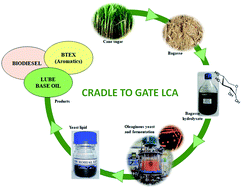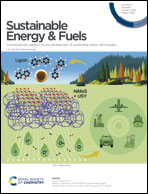Yeast lipid-based biofuels and oleochemicals from lignocellulosic biomass: life cycle impact assessment†
Abstract
Over the last few decades, much attention has been paid to various applications of microbial oil, including for transportation. Lignocellulosic biomass has been chosen to produce fuels and chemicals using different chemical/conversion pathways, although the excessive use of chemicals and solvents during the processes are issues of immediate environmental concern. Rhodotorula mucilaginosa IIPL32 (RMIIPL32) being an oleaginous yeast can accumulate triglycerides (lipid) through fermentation of xylose, extracted from pre-treatment of sugarcane bagasse. In this study, environmental impacts have been assessed for the generation of the lipid and its conversion into biodiesel, lube base oil and BTEX (benzene, toluene, ethyl benzene and xylene). Uncertainty analysis was carried out for all the emissions under the environmental impact categories for the processes. The emissions investigated for global warming potential (GWP) are found to be 260.03, 572.16, 27.83 and 85.19 kg CO2 equivalent for non-polar lipid, lube base oil, biodiesel and BTEX processes. The uncertainty is also found to be lower for GWP (i.e., <0.3) for all the processes. This is the first LCA report for yeast lipid production from sugarcane bagasse. Therefore, this study can be beneficial for the scale-up of yeast lipid fermentation and its conversion into high value products.



 Please wait while we load your content...
Please wait while we load your content...